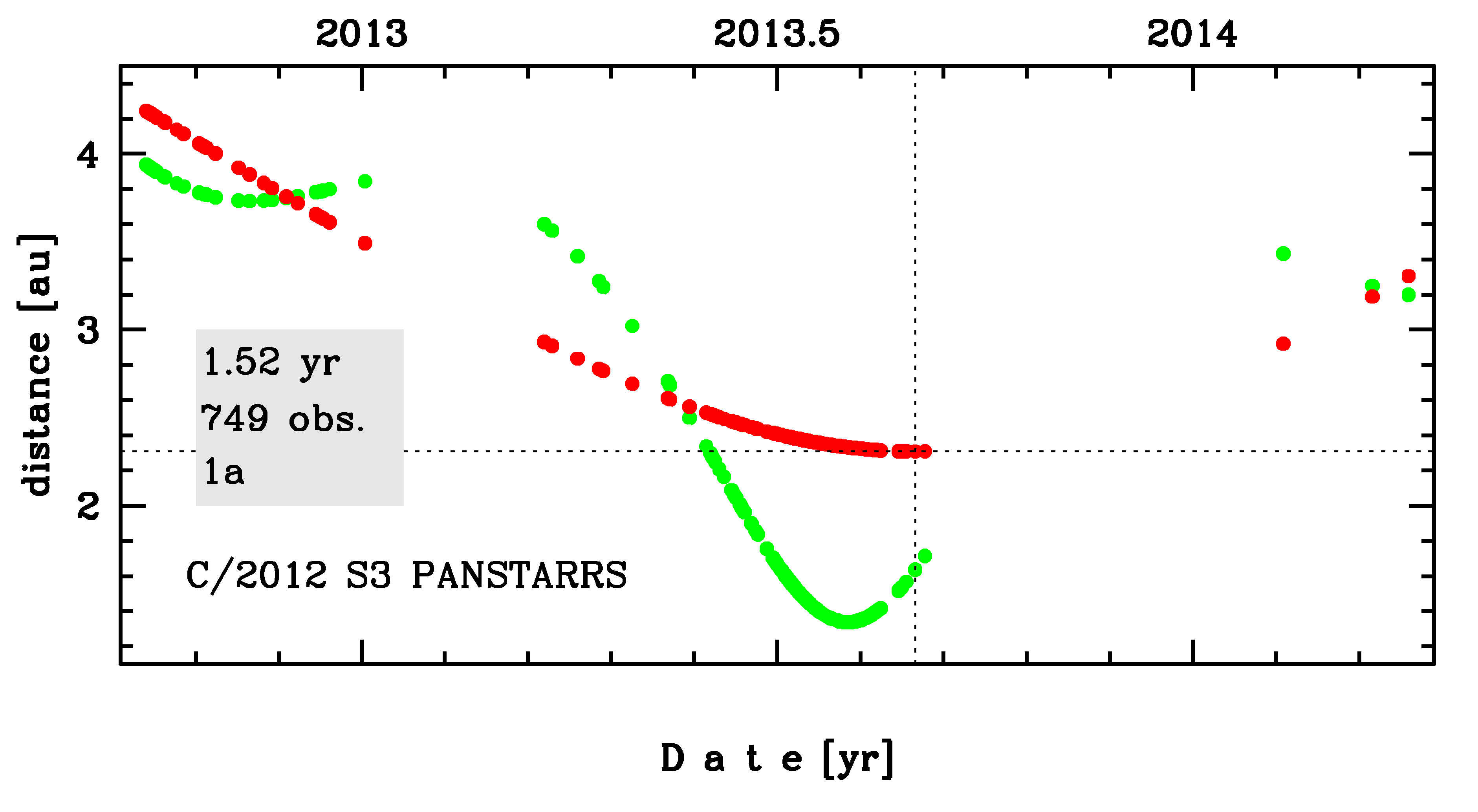C/2012 S3 PANSTARRS
more info
Comet C/2012 S3 was discovered on 27 September 2012 with Pan-STARRS 1 telescope (Haleakala), that is 11 months before its perihelion passage. It was observed until 4 April 2014 (see picture).
C/2012 S3 had its closest approach to the Earth on 1 August 2013 (1.338 au), about a month before its perihelion passage.
Solutions given here are based on data spanning over 1.52 yr in a range of heliocentric distances: 4.25 au – 2.308 au (perihelion) – 3.30 au.
This Oort spike comet suffers rather small planetary perturbations during its passage through the planetary system that cause a tighter future orbit (see future barycentric orbits).
C/2012 S3 had its closest approach to the Earth on 1 August 2013 (1.338 au), about a month before its perihelion passage.
Solutions given here are based on data spanning over 1.52 yr in a range of heliocentric distances: 4.25 au – 2.308 au (perihelion) – 3.30 au.
This Oort spike comet suffers rather small planetary perturbations during its passage through the planetary system that cause a tighter future orbit (see future barycentric orbits).
| solution description | ||
|---|---|---|
| number of observations | 749 | |
| data interval | 2012 09 27 – 2014 04 04 | |
| data type | significantly more measurements before perihelion (PRE+) | |
| data arc selection | entire data set (STD) | |
| range of heliocentric distances | 4.25 au – 2.31 au (perihelion) – 3.3 au | |
| detectability of NG effects in the comet's motion | comet with determinable NG~orbit | |
| type of model of motion | GR - gravitational orbit | |
| data weighting | YES | |
| number of residuals | 1481 | |
| RMS [arcseconds] | 0.39 | |
| orbit quality class | 1a | |
| previous orbit statistics, both Galactic and stellar perturbations were taken into account | ||
|---|---|---|
| no. of returning VCs in the swarm | 5001 | * |
| no. of escaping VCs in the swarm | 0 | |
| no. of hyperbolas among escaping VCs in the swarm | 0 | |
| previous reciprocal semi-major axis [10-6 au-1] | 34.57 – 35.52 – 36.48 | |
| previous perihelion distance [au] | 756 – 779 – 799 | |
| previous aphelion distance [103 au] | 54.1 – 55.5 – 57.1 | |
| time interval to previous perihelion [Myr] | 4.52 – 4.7 – 4.89 | |
| percentage of VCs with qprev > 20 | 100 | |
| previous_g orbit statistics, here only the Galactic tide has been included | ||
|---|---|---|
| no. of returning VCs in the swarm | 5001 | * |
| no. of escaping VCs in the swarm | 0 | |
| no. of hyperbolas among escaping VCs in the swarm | 0 | |
| previous reciprocal semi-major axis [10-6 au-1] | 35.22 – 36.11 – 37.02 | |
| previous perihelion distance [au] | 8.4 – 9.6 – 11 | |
| previous aphelion distance [103 au] | 54 – 55.4 – 56.8 | |
| time interval to previous perihelion [Myr] | 4.43 – 4.59 – 4.77 | |
| percentage of VCs with qprev < 10 | 67 | |
| percentage of VCs with 10 < qprev < 20 | 33 | |
